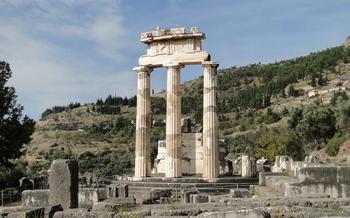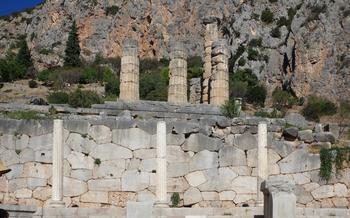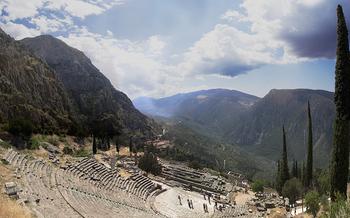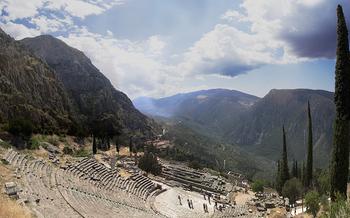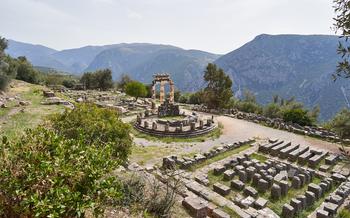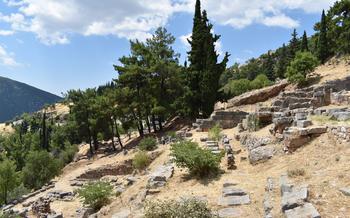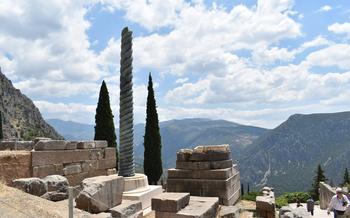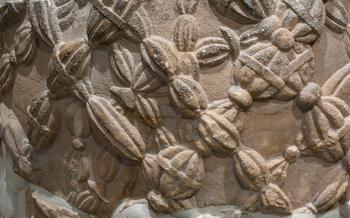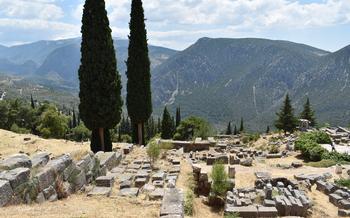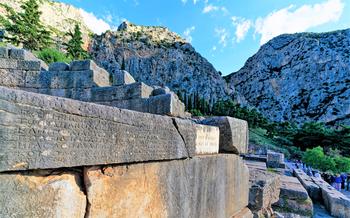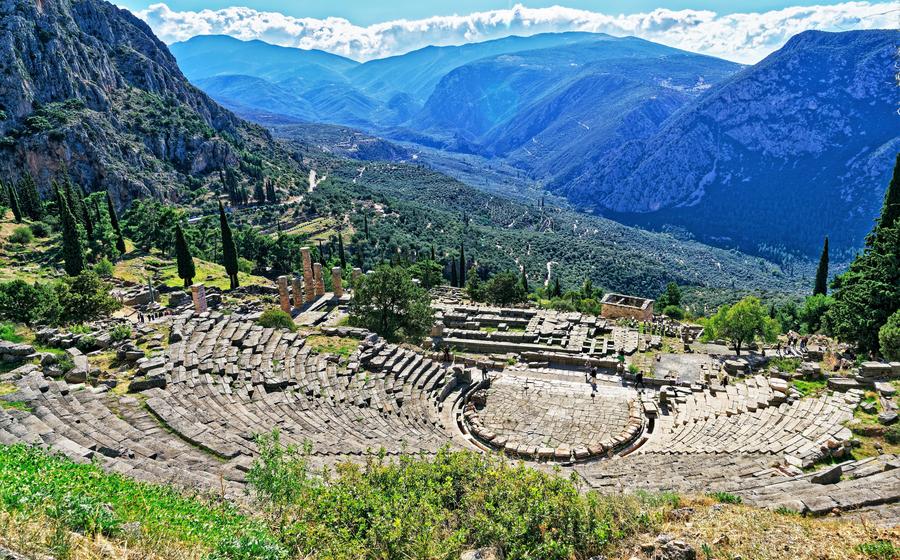
The Bridge of Arta
- Delphi: A Place of Antiquity and Wonder
- Unveiling the Intriguing History of Delphi
- Exploring the Archaeological Museum of Delphi
- Marveling at the Archaeological Site of Delphi
- The Legendary Castalian Spring
- The History of the Delphi Oracle
- The Treasury of the Athenians
- The Terrace of the Lions
- The Tholos of Delphi
- Unveiling the Stadium of Delphi
- Exploring the Sanctuary of Athena Pronaia
- Marveling at the Charioteer of Delphi
- Discovering the Museum of Delphi
- Hiking the Sacred Way
- Insider Tip: Plan Your Visit Wisely
Delphi: A Place of Antiquity and Wonder
Nestled in the heart of Greece, Delphi stands as a testament to the ancient world's grandeur and mystique. This captivating city, steeped in history and mythology, was once a flourishing city-state and a renowned religious center. Its fame was such that it was considered the center of the world by the ancient Greeks, a place where the divine and the mortal intertwined.
The historical significance of Delphi is undeniable. It was a thriving city-state in ancient Greece, renowned for its wealth and influence. Its strategic location at the foot of Mount Parnassus and its natural resources, including the famed Castalian Spring, contributed to its prosperity. The city's reputation was further enhanced by its reputation as a Panhellenic sanctuary, a place of pilgrimage and worship for people from all over the Greek world.
Mythology played a significant role in shaping Delphi's identity. According to legend, Zeus, the king of the gods, released two eagles from opposite ends of the world. The birds met at Delphi, marking it as the center of the world. The site was also associated with Apollo, the god of prophecy, who was said to have slain the serpent Python and established his oracle at Delphi.
The Oracle of Delphi was one of the most famous and influential oracles in the ancient world. People from all walks of life, including kings, statesmen, and ordinary citizens, sought the oracle's advice on matters of war, politics, and personal life. The oracle's prophecies, delivered by the priestess Pythia, were believed to be the words of Apollo himself and were often cryptic and open to interpretation.
In recognition of its outstanding historical and cultural value, Delphi was designated a UNESCO World Heritage Site in 198This prestigious designation highlights the enduring legacy of Delphi and its significance as a place of exceptional universal value.
Unveiling the Intriguing History of Delphi
Delphi, a city-state of ancient Greece, holds a prominent place in the annals of history. It served as a panhellenic sanctuary, revered by Greeks and foreigners alike, and was considered the center of religious and cultural life in the ancient world. The city's fame stemmed from the Oracle of Delphi, which attracted pilgrims and envoys seeking divine guidance and prophecies.
Delphi's significance extended beyond its religious status. It was a thriving city-state with a vibrant political and economic life. The city's strategic location at the foot of Mount Parnassus and its control over the sacred oracle brought prosperity and influence. Delphi hosted festivals, games, and competitions that drew participants from all over Greece, further solidifying its position as a major cultural center.
The city's profound impact on Greek history and culture is reflected in its numerous sanctuaries, temples, and theaters. These monumental structures, dedicated to various deities and used for religious rituals and performances, attest to the city's deep-rooted spiritual and artistic traditions. Delphi's legacy as a center of ancient wisdom and enlightenment continues to inspire and captivate visitors from around the world.
Exploring the Archaeological Museum of Delphi
Nestled at the foot of Mount Parnassus, the Archaeological Museum of Delphi houses a treasure trove of artifacts that unveil the rich history and cultural significance of this ancient sanctuary. Step inside to embark on a journey through time, where masterpieces of ancient Greek art and intriguing relics await.
The museum's collection spans from the Archaic to the Hellenistic periods, offering a comprehensive glimpse into Delphi's evolution as a religious and cultural center. Among the highlights is the renowned Charioteer of Delphi, a bronze statue that embodies the pinnacle of classical Greek sculpture. With its lifelike details and exceptional craftsmanship, this masterpiece captures the essence of athletic prowess and artistic achievement.
Other notable exhibits include the Sphinx of Naxos, an enigmatic creature with a human head and a lion's body, and the metope sculptures from the Treasury of the Athenians, depicting scenes from the labors of Hercules. These exquisite works of art provide valuable insights into Delphi's mythology and religious beliefs, offering a glimpse into the minds of the ancient Greeks.
The museum also houses a vast array of pottery, jewelry, inscriptions, and everyday objects, each telling its own story about life in ancient Delphi. These artifacts offer a tangible connection to the past, allowing visitors to piece together the daily lives and rituals of the people who inhabited this sacred site.
Whether you're a history buff, an art enthusiast, or simply curious about the ancient world, the Archaeological Museum of Delphi is a must-visit destination. Its collection offers a profound understanding of the significance of this oracle, the artistic achievements of ancient Greece, and the enduring legacy of Delphi as a place of worship, prophecy, and cultural exchange.
Marveling at the Archaeological Site of Delphi
A visit to the archaeological site of Delphi is a journey through time, where the ruins of ancient temples, theaters, and treasuries stand as testaments to the city's former glory. The site is a treasure trove of well-preserved monuments, offering a glimpse into the religious, cultural, and political life of ancient Greece.
At the heart of the sanctuary lies the Temple of Apollo, an imposing structure that once housed the oracle of Delphi. The temple's grand columns and intricate pediments have withstood the test of time, providing a glimpse into the architectural prowess of the ancient Greeks. Nearby, the Sanctuary of Athena Pronaia offers a serene and picturesque setting, with its well-preserved tholos and temple.
The Theater of Delphi, built into the hillside, is a marvel of ancient engineering. Its tiers of stone seats rise steeply, providing spectators with a breathtaking view of the surrounding landscape. The theater hosted dramatic performances, musical concerts, and religious ceremonies, serving as a vibrant cultural hub for the ancient city.
As you wander through the archaeological site, you'll encounter a wealth of other ruins, each with its own story to tell. From the Treasury of the Athenians, with its exquisite relief sculptures, to the Terrace of the Lions, with its row of imposing stone guardians, every corner of Delphi holds a hidden gem waiting to be discovered.
The Legendary Castalian Spring
Nestled amidst the picturesque slopes of Mount Parnassus, the Castalian Spring holds a prominent place in Greek mythology and history. Considered sacred in ancient times, this natural spring was believed to possess the power to inspire poets, prophets, and seekers of knowledge.
According to myth, the Castalian Spring was created when the hoof of the winged horse Pegasus struck the ground, releasing a stream of pure water. The spring became a sanctuary for the Muses, the nine goddesses who presided over the arts and sciences. It was said that those who drank from its waters would be blessed with poetic inspiration and divine wisdom.
In ancient times, the Castalian Spring was an integral part of the Delphic sanctuary. Devotees and pilgrims would visit the spring to purify themselves before seeking the oracle's prophecies. The spring was also a popular gathering place for poets and philosophers, who would come to seek inspiration and exchange ideas.
Today, the Castalian Spring remains a captivating site for visitors to Delphi. The ancient fountain house, which once channeled the spring's waters, has been restored, and visitors can still see the inscriptions left by ancient visitors. The picturesque setting, surrounded by olive groves and towering mountains, adds to the allure of this sacred spring.
The History of the Delphi Oracle
Whispers of Prophecy: Unveiling the Secrets of the Delphi Oracle
Within the sacred precinct of Delphi, a figure known as the Pythia, or oracle, held sway. This enigmatic priestess served as a conduit between the mortal realm and the divine, delivering prophecies that shaped the course of history. Believed to be chosen by Apollo, the god of prophecy, the Pythia would enter a trance-like state, uttering cryptic messages that were interpreted by priests and disseminated to those seeking guidance.
Her prophecies, often shrouded in ambiguity, held immense influence over the decisions of individuals, cities, and even entire nations. From matters of war and peace to the founding of new colonies, the oracle's words carried weight and were sought by rulers, statesmen, and ordinary citizens alike.
The oracle's influence extended far beyond the borders of Greece. Kings from distant lands, including Lydia, Egypt, and Rome, sent emissaries to Delphi to seek divine counsel. The oracle's prestige reached its peak in the 6th century BC, when it became a symbol of unity and shared identity among the Greek city-states.
Though the oracle's pronouncements were often enigmatic and open to interpretation, they played a significant role in shaping the course of Greek history. The oracle's legacy lives on, a testament to the enduring power of faith and the human desire for guidance from the divine.
The Treasury of the Athenians
Commemorating Athenian power and prestige, the Treasury of the Athenians stands as a testament to the city's significant role in the Delphic sanctuary. Constructed in the 5th century BC, this impressive structure is a Doric-style temple dedicated to Athena, the goddess of wisdom and warfare.
The Treasury's architectural details are exquisite, showcasing the refined craftsmanship of ancient Greek builders. Its facade features six Doric columns supporting a triangular pediment, adorned with intricate relief sculptures depicting mythological scenes. These sculptures, remarkably well-preserved, offer a glimpse into the myths and legends that permeated ancient Greek society.
Inside the Treasury, visitors can admire the coffered ceiling, a masterpiece of stone carving. The coffered panels are decorated with painted rosettes, adding a touch of color and elegance to the interior. The Treasury's refined ornamentation and harmonious proportions exemplify the architectural prowess of the Athenians, who were renowned for their contributions to classical Greek art and architecture.
As one of the most prominent structures within the sacred precinct of Delphi, the Treasury of the Athenians symbolizes the city's deep connection to the sanctuary and its commitment to honoring the gods. It serves as a reminder of the profound influence that Athens wielded in the religious and political landscape of ancient Greece.
The Terrace of the Lions
Perched atop a majestic terrace, a row of awe-inspiring stone lions stands guard, their stoic presence adding an air of grandeur to the sacred landscape of Delphi. These impressive creatures, carved from Naxian marble, once lined the sacred way, the processional route that led pilgrims and worshippers to the sanctuary of Apollo. Their fierce expressions and muscular bodies exude both strength and majesty, instilling a sense of awe in all who behold them.
The Terrace of the Lions served as a grand entrance to the sanctuary, symbolizing the power and protection of the gods. Each lion, meticulously crafted with intricate details, represents the artistry and skill of ancient Greek sculptors. Their unwavering gaze seems to follow visitors as they ascend the terrace, creating a palpable connection between the past and the present.
Beyond their symbolic significance, the lions also offer breathtaking views of the surrounding landscape. From their elevated position, visitors can gaze out over the olive groves and vineyards that blanket the valley below, with the distant mountains forming a dramatic backdrop. The panoramic vistas from the terrace provide a perfect opportunity to pause and reflect on the rich history and natural beauty that converge in this sacred place.
As you stand among these majestic creatures, let your imagination transport you back in time to the days when pilgrims and athletes made their way to Delphi, seeking divine guidance and paying homage to the gods. The Terrace of the Lions, with its powerful symbolism and stunning views, invites you to immerse yourself in the grandeur and mystery of this ancient sanctuary.
The Tholos of Delphi
Nestled amidst the ruins of Delphi, the Tholos of Delphi stands as a testament to the architectural prowess and enigmatic history of ancient Greece. This circular building, constructed in the 4th century BC, captivates visitors with its unique design and intriguing purpose.
Composed of 20 Doric columns arranged in a ring, the Tholos exudes an aura of symmetry and elegance. Its circular shape, a departure from the traditional rectangular temples of the era, hints at its distinct function. While the exact purpose of the Tholos remains a subject of debate, scholars have proposed various theories, ranging from a treasury to a dining hall for distinguished guests.
One prominent theory suggests that the Tholos served as a treasury, housing the wealth and offerings dedicated to the sanctuary of Apollo. The circular design may have provided enhanced security, protecting the precious treasures within. Alternatively, the Tholos might have functioned as a dining hall, where prominent individuals and officials gathered for ceremonial banquets or feasts in honor of the gods.
Regardless of its precise purpose, the Tholos of Delphi stands as a testament to the ingenuity and artistry of ancient Greek architects. Its unique design, combined with its historical significance, makes it a must-see attraction for anyone exploring the wonders of Delphi.
Unveiling the Stadium of Delphi
A Place of Ancient Sports and Athleticism
Nestled amidst the ancient ruins of Delphi, the Stadium of Delphi stands as a testament to the athletic prowess and competitive spirit of the ancient Greeks. Built in the 5th century BC, this impressive sports venue hosted the Pythian Games, one of the four major Panhellenic games in ancient Greece, held in honor of the god Apollo.
With a capacity of over 5,000 spectators, the stadium was a marvel of ancient engineering. Its well-preserved seating areas, starting lines, and judges' stand provide a glimpse into the world of ancient Greek athletics. Visitors can imagine the roar of the crowd as athletes competed in footraces, wrestling, boxing, and other sports, striving for victory and glory.
The stadium's location, nestled amidst the dramatic cliffs and valleys of Delphi, adds to its allure. Spectators and athletes alike would have been treated to breathtaking views of the surrounding landscape, making the Pythian Games an unforgettable experience for all who attended.
Today, the Stadium of Delphi stands as a reminder of the importance of sports and athleticism in ancient Greek culture. It invites visitors to step back in time and experience the excitement and energy of these ancient competitions, where physical prowess and the pursuit of excellence were celebrated.
Exploring the Sanctuary of Athena Pronaia
A short distance from the main archaeological site of Delphi lies the Sanctuary of Athena Pronaia, a separate sacred area dedicated to the goddess Athena. This sanctuary, also known as Marmaria, played a significant role in Delphi's religious and cultural life.
While the Sanctuary of Apollo was associated with prophecy and divination, the Sanctuary of Athena Pronaia was primarily dedicated to Athena as a protector and guardian of the city. It was believed that Athena's presence ensured the safety and prosperity of Delphi.
The sanctuary is home to several notable structures, including the Tholos of Athena Pronaia, a unique circular building with Doric columns. This tholos is one of the most recognizable landmarks of Delphi and is believed to have served as a treasury or a dining hall.
Other ruins within the sanctuary include the Temple of Athena Pronaia, which dates back to the 4th century BC, and various other foundations and buildings. Visitors can explore these ruins and gain insights into the religious practices and rituals associated with Athena's worship in ancient Delphi.
The Sanctuary of Athena Pronaia offers a serene and contemplative atmosphere, allowing visitors to connect with the ancient history and spirituality of this sacred site. Its proximity to the main archaeological site makes it a must-visit destination for anyone interested in exploring the full extent of Delphi's rich history and heritage.
Marveling at the Charioteer of Delphi
Among the many treasures unearthed at Delphi, the Charioteer of Delphi stands as a testament to the unparalleled artistry of ancient Greece. This bronze statue, dating back to the 5th century BC, is a masterpiece of precision and detail, capturing the essence of athleticism and artistic achievement.
The charioteer, depicted with remarkable realism, exudes a sense of determination and concentration as he guides his four-horse chariot. The intricate details of the statue, from the intricate folds of the charioteer's garments to the finely rendered muscles of the horses, showcase the exceptional craftsmanship of the ancient Greek sculptors.
Standing at an impressive height of over two meters, the Charioteer of Delphi is a symbol of athletic prowess and artistic triumph. Originally part of a larger monument commemorating a chariot race victory, the statue was dedicated to Apollo, the patron god of Delphi.
Today, the Charioteer of Delphi resides in the Archaeological Museum of Delphi, where visitors can marvel at its beauty and appreciate its historical significance. This iconic statue is not only a masterpiece of ancient art but also a symbol of the spirit of competition and excellence that defined ancient Greece.
Discovering the Museum of Delphi
Nestled amidst the evocative ruins of Delphi, the Museum of Delphi stands as a beacon of knowledge, showcasing a remarkable collection of artifacts that illuminate the rich history and cultural significance of this ancient city. Within its modern and spacious galleries, visitors embark on a captivating journey through time, exploring the diverse treasures unearthed from the archaeological site.
The museum's exhibits are a testament to the artistic prowess and religious devotion of the ancient Greeks. Exquisite sculptures, intricately painted pottery, and fascinating inscriptions narrate the stories of gods, heroes, and ordinary people who once inhabited this sacred place. Among the highlights of the collection is the renowned Charioteer of Delphi, a bronze masterpiece that captures the essence of athleticism and artistic achievement.
Interactive exhibits and multimedia presentations bring the ancient world to life, providing visitors with a deeper understanding of Delphi's history, mythology, and religious practices. Through these immersive experiences, visitors gain insights into the significance of the Oracle of Delphi, the Panhellenic Games, and the everyday lives of the people who called this sacred city home.
A visit to the Museum of Delphi is an essential complement to exploring the archaeological site. Together, they offer a comprehensive and captivating glimpse into the grandeur and legacy of one of the most important religious and cultural centers of the ancient world.
Hiking the Sacred Way
Embark on a journey through time as you follow the footsteps of ancient pilgrims along the Sacred Way. This ancient path served as the main artery connecting Delphi to the Sanctuary of Athena Pronaia, a sanctuary dedicated to the goddess Athena. As you traverse this picturesque route, immerse yourself in the serene beauty of olive groves and encounter remnants of ancient ruins that whisper tales of a bygone era.
The Sacred Way winds its way through a captivating landscape, offering panoramic vistas of the surrounding countryside. With each step, you'll feel a palpable connection to the past, transported back to a time when priests, athletes, and dignitaries made their way to the oracle to seek guidance and pay homage to the gods.
Whether you choose to walk the entire path or embark on a shorter section, the Sacred Way promises an immersive experience that blends ancient history with the tranquility of nature. Let the spirit of antiquity envelop you as you traverse this sacred route, marveling at the enduring legacy of Delphi.
Insider Tip: Plan Your Visit Wisely
To make the most of your visit to Delphi, careful planning is essential. The best time to explore this ancient site is during the shoulder seasons (spring and autumn) when the weather is pleasant, and the crowds are smaller. This allows you to wander through the ruins and soak in their history without feeling rushed or overwhelmed.
When packing for your trip, prioritize comfortable shoes, as you'll be doing a lot of walking on uneven surfaces. Don't forget to bring plenty of water and sun protection, especially during the hotter months.
Before embarking on your journey, take some time to learn about the history and significance of Delphi. This will enhance your understanding and appreciation of the site. Consider hiring a knowledgeable guide who can provide insights and anecdotes that bring the ancient city to life.
